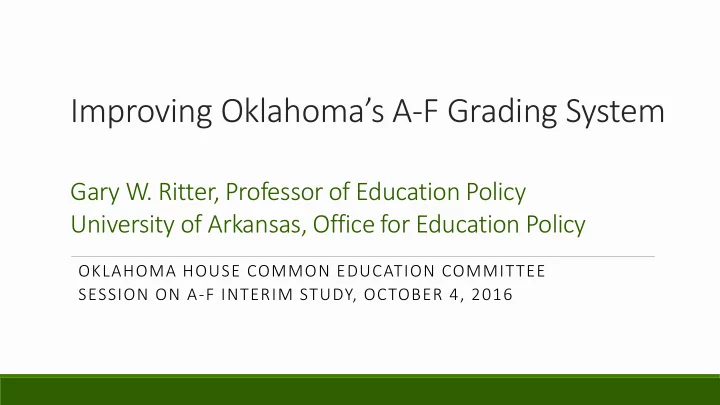

Improving Oklahoma’s A-F Grading System Gary W. Ritter, Professor of Education Policy University of Arkansas, Office for Education Policy OKLAHOMA HOUSE COMMON EDUCATION COMMITTEE SESSION ON A-F INTERIM STUDY, OCTOBER 4, 2016
Today’s P Pres esen entation 1. Why Grade (or Rate) Schools? 2. Boundaries ◦ Current Oklahoma Context ◦ Current (and existing) Federal Regulations ◦ Intersection 3. Desirable Goals for OK A-F 4. Principles of a Good School Grading System 5. Traps to Avoid! 6. Where Does OK go from Here?
1. I Introd oduction on: Why G Grad ade S e School ools? For Parents Is this school a good school? For School Leaders Is my school performing well? Where can we improve? For Policy Makers Which schools are performing well and should be rewarded and which schools are not and need support? What goals do we want to incentivize schools to pursue?
2a. Bo Bound undary: Cur Current O Oklaho homa Co Context A-F grades assigned to schools beginning in 2011 Current Model: 50% achievement 50% growth + some bonus points Questions: • Do the grades meaningfully differentiate among schools? • How are the grades connected to federal accountability? • Do the grades include what is important? (e.g. growth) • Are the grades Truthful and Useful ?
2b. b. Bo Bound undary: Cur Current Na National Co Context ESSA Required Annual Accountability Indicators • Academic Proficiency: measured by annual state assessments • Another Academic Indicator (ES/MS) : must be valid and reliable; can be growth • Graduation Rate (HS): 4-year adjusted cohort (can request extended rate) • English Learners’ Progress in attaining proficiency in English • School quality or student success indicator (At least one- less weight than others)
Other Ot er P Possible e Meas asures es of School ool Qu Qual ality Deeper Learning Equity and School culture Career Readiness Skills and opportunity to learn and climate Dispositions Completion of approved Course access • Student and staff Social-emotional skills • • • CTE sequence or career Enrollment and completion of perceptions of school Attitudes toward learning • • pathway rigorous coursework offerings, instruction, trust, Performance-based • Earned certificates, Ratios of students to highly etc assessments of cross- • • licenses or badges effective teachers, counselors, • Teacher, parent or curricular skills recognized by industry specialists community engagement or Post-Secondary Safe, adequate facilities • Chronic absenteeism • institutions Access to technology • Discipline • New teacher retention This is a new • Teacher attendance but important • Achievement Gap Closure possibility •
2c. C Con onnecting Okl klahoma an and Natio ional C l Con ontext • ESSA allows states to developing their own accountability plans within the framework (don’t be driven only by ESSA) • Included data must be able to be disaggregated by student groups (prior research in CA, NY, NC, SC, TX supports) • Included data must must ‘meaningfully differentiate’ among schools (Attendance rate won’t, but chronic absenteeism will)
3. 3. Desi Desirable Go Goals f s for OK A K A-F • Meaningfully communicate with stakeholders about how schools are performing on metrics important to the state and community • Serve as a part of continuous improvement process for schools • Align with federal accountability- just one system Be Truthful and Useful
3. Un Under erlyi ying A g Assumption ons • Good tests and good data management • Growth measured at student-level over time (not successive cohorts) • School- level reports (for this discussion) • Research doesn’t provide prescriptive guidance
Oklahoma: + Assigns overall grade + Includes Achievement and Growth + Letter grades for different areas + Includes advanced coursework (bonus) +Includes focus on lowest 25% of students 10
Louisiana: + Overall grade + Easy to understand change + College-going rates + Subgroup information - Too Cluttered! 11
New York: + Separate scores for different sections + Focus on learning environment - No information of prior performance - No context about relative quality
California: + Performance and growth + Extended graduation rates + Chronic absenteeism - No overall rating - Difficult to tell if good or bad
Alberta: + Achievement and Improvement + Work Preparation + Color-coded - A LOT of information!
Illinois: + Teacher retention + Financial info - Difficult to determine if good or bad?
Ohio: + Easy to read + Achievement + Progress + Gap + K-3 Literacy 16
4. Principles es o of a Goo ood S School ol G Grad ading S g System em • Transparent and Understandable for parents and community • Focused on Growth, not simply “point-in-time” success • Includes information on school context ( perhaps in rating ) • Examines important student groups • Reflects the priorities of the state and communities • Aligned with outside ratings • Includes key metrics, but not too many! • Should include an overall score (or two) 17
5. T Traps to to A Avoid! • Too many indicators- obfuscation in the name of 100% transparency (need clarity of message) • Over-simplifying- Advanced is different than Proficient • Stopping growth at Proficient • Choosing indicators that aren’t aligned to state goals • Putting data that is ‘informational’ into accountability model • Don’t rate just on proficiency 18
5. T Traps to to A Avoid! • Unintended consequences- good indicators going bad • Proficiency -> ‘teaching to the test’ • Graduation Rate -> watering down of criteria • ACT scores -> decreased ACT participation • Chronic absence -> increased in-school discipline 19
6. Wher ere D e Does es OK OK Go F From om He Here? e? • What is meaningful to the state and communities? • Consider what data are currently collected and available for use at the state level • Can it be disaggregated to school and subgroup level? • Consider what data would need to be collected • Exercise caution with untried measures • Again, schools respond to incentives – what do OK policymakers want to incentivize? 20
Questions? Thank you! 21
Recommend
More recommend